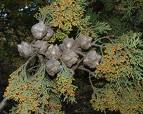MacNab Cypress Tree Information
Images of MacNab Cypress:






MacNab Cypress grows in the following 1 states and provinces:
CaliforniaInformation about MacNab Cypress:
as well ashe Cupressus Macnabiana is commonly known as the MacNab Cypress.
The currently accepted scientific name of MacNab cypress is Cupressus macnabiana Murr. . There are no recognized infrataxa. Natural hybridization between MacNab cypress and Sargent cypress (Cupressus sargentii) has been hypothesized, but evidence for it is inconclusive .MacNab cypress occurs only in California and has the widest distribution of any of the California cypress . Numerous scattered groves occur in the inner North Coast Ranges, the Sierra Nevada foothills, and the Cascade Range . Over 30 groves occur in the following counties: Sonoma, Napa, Yolo, Mendocino, Lake, Colusa, Tehama, Shasta, Butte, Nevada, Yuba, and Amador .MacNab cypress is a component of the northern interior cypress forest. This community is an open, fire-maintained, scrubby forest similar to the knobcone pine (Pinus attenuata) forest. It is associated with serpentine chaparral, and intergrades on less severe sites with upper Sonoran mixed chaparral, montane chaparral, or knobcone pine forest community types. On more mesic sites the northern interior cypress forest intergrades with mixed evergreen forest or montane coniferous forest . MacNab cypress is associated with redwood (Sequoia sempervirens)-Douglas-fir (Pseudotsuga menziesii) forest and associated North Coast forests in Mendocino County, California . It is also commonly associated with chaparral and pine-oak (Pinus-Quercus spp.) woodland species . The Magalia grove in Butte County is surrounded by yellow pine forest (Pinus ponderosa and P. jeffreyi) . MacNab cypress occurs sympatrically with Sargent cypress in Lake County, California . Publications naming MacNab cypress as a community dominant are listed below. Terrestrial natural communities of California Terrestrial vegetation of California Species not previously mentioned but commonly associated with MacNab cypress include gray pine (Pinus sabiniana), sugar pine (P. lambertiana), incense-cedar (Libocedrus decurrens), California scrub oak (Quercus dumosa), leather oak (Q. durata), interior live oak (Q. wislizenii), valley oak (Q. lobata), Sierra coffeeberry (Rhamnus rubra), California coffeeberry (R. californica), yerba santa (Eriodictyon californicum), chaparral pea (Pickeringia montana), golden-fleece (Haplopappus arborescens), Garrya congdonii (interior silktassel), California hop tree (Ptelea crenulata), chamise (Adenostoma fasciculatum), wedgeleaf ceanothus (Ceanothus cuneatus), musk brush (C. jepsonii), whiteleaf manzanita (Arctostaphylos viscida), creeping sage (Salvia sonomensis), and styrax (Styrax officinalis var. californica) . Some of the information provided here is attributed to:Esser, Lora L. 1994 Cupressus macnabiana. In: Fire Effects Information System, [Online]. U.S. Department of Agriculture, Forest Service, Rocky Mountain Research Station, Fire Sciences Laboratory (Producer). , available at the USDA Fire Effects Information System (FEIS) website